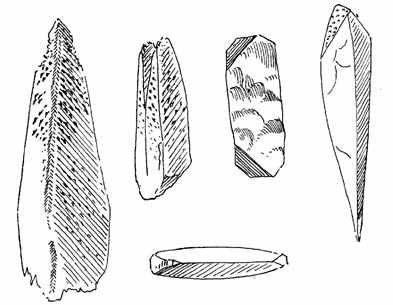
|
|
ERWIN HINCKLEY BARBOUR.
During the past two years there have been
several additions to the list of Nebraska minerals. Chief among
them are the closely related minerals Barite and Celestite.
Because of the larger collections and the better knowledge of the
barites they will be made the subject of this paper.
Our barites occur in three rather distinct
forms, the flat or tabular crystals of southeastern Nebraska; the
superb prismatic crystals of the "Bad Lands," and the fibrous dike
barite found in the Hat Creek basin of the Little Bad Lands in
Sioux county. In southeastern Nebraska, in the Permian of Gage
county, near Odell, Wymore, and Beatrice, barites are found quite
abundantly in the clays. Because of their shape and frequent
occurrence these beds have become known locally as the "Diamond
Fields."
The barite group belongs crystographically to
the orthorhomic system, that is, the three axes are all at right
angles, but are each of different length, accordingly the prism
may be developed along different axes, making ever varying forms
of crystals. The common form of crystal is flat and tabular,
sometimes, however, they are long and needle like, at other times
thick, strong prisms. The form found in Gage county is a flat,
diamond shaped crystal from one to three millimeters in thickness.
The largest of these will scarcely measure more than ten to
fifteen millimeters (three-eighths to one-half inch) in length. It
is a common feature of these crystals to show alternating bands of
white, brown, or yellow color, parallel to the edges of the
crystal; also a dark cross imitating axes is often present. The
yellow portion, according to Dana, is the less pure barite, being,
in fact, a pretty nearly equal mixture of barium sulphate and
calcium
18
|
|
266 |
carbonate. In addition to these it is not uncommon for
barite to contain impurities in the way of silica, clay, and
bituminous or carbonaceous substances. The more transparent
crystals show phantom figures to perfection.
These are all the more interesting to the
Nebraska mineralogist from the fact that. they are undescribed for
the state.
In the Bad Lands there are thin dikes running in
all directions over the hills. These are generally dikes of
chalcedony, and stand but little above the bare clays of the
region. In other cases there is a filling of calcite with selvages
of chalcedony. There are besides, occasionally dikes of sandstone
a half meter thick, and even dikes of clay.
On the last expedition sent out by the State
University - the Morrill Geological Expedition of 1895, - the
students found uncommon and altogether unexpected dikes of fibrous
barite of a bluish color. The dike was scarcely more than fifteen
to twenty millimeters (a half to three-quarters of an inch) thick,
yet it could be traced for some distance across the Bad Land
marls. The dike was vertical, the fibers at right angles to its
plane. This is the first known occurrence of Barite in any form in
this locality.
Further north in the Big Bad Lands a magnificent
array of barites is found in the Fort Pierre shale. These are
occasionally of striking size, and of great superiority of color
and crystalization. The prevailing type is a long, tapering,
prismatic crystal of a fine amber color. There are occasional
crystals found which are almost pure and transparent. Some are
less distinctly crystallized and are arranged in conspicuously
radiated bunches.
The mode of occurrence is an interesting
feature. Wherever the country is cut into hills by recent drainage
lines, one can trace along the hillsides a band made conspicuous
by its nodules or concretions. These vary in size from the
diameter of the fist to those exceeding that of the outstretched
arms. These are exposed along the Cheyenne river and its many
tributaries. The concretions are of that peculiar type, known as
septaria.
There is a well recognized tendency of matter in
solution,--hence
|
|
267 |
free to arrange itself molecularly,--to become segregated, or aggregated together around a center, making more or less spherical masses. Thus it is that we find in the shales of the Fort Pierre Cretaceous great concretions of the same material, though rendered hard and dense. These clay balls when drying from the original plasticity, harden first on the surface. Naturally then, as the interior dried there would be all sorts of shrinkage cracks and irregular cavities left within. Here we

FIGURE 2.--A group of amber-colored barite crystals from the Bad Lands, showing etched and doubly terminated forms. The natural etching of these crystals is often rather remarkable. Doubly terminated crystals are rare. Natural size.
have formed a beautiful receptacle for the magnificent crystals which are to be formed within these drying mud-balls. Soon water with calcium carbonate in solution coats all the surfaces with a layer of impure and discolored calcite. Succeeding layers are of better color and crystallization. Generally the cavities are lined with small crystals of dog-tooth spar of an orange color; upon these rest clear, sharp crystals of nail-head calcite,



© 2000, 2001 for NEGenWeb Project by Pam Rietsch, T&C Miller